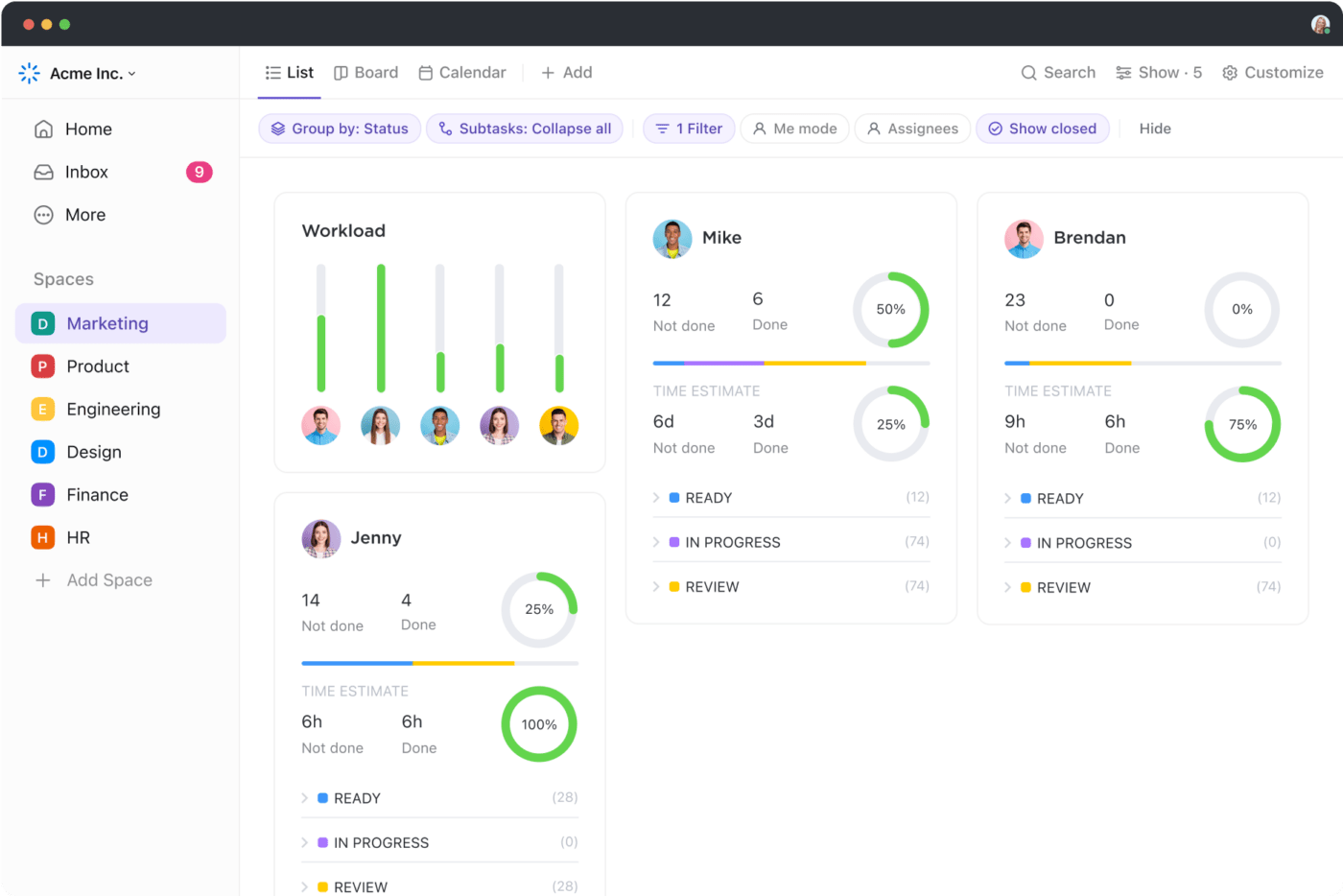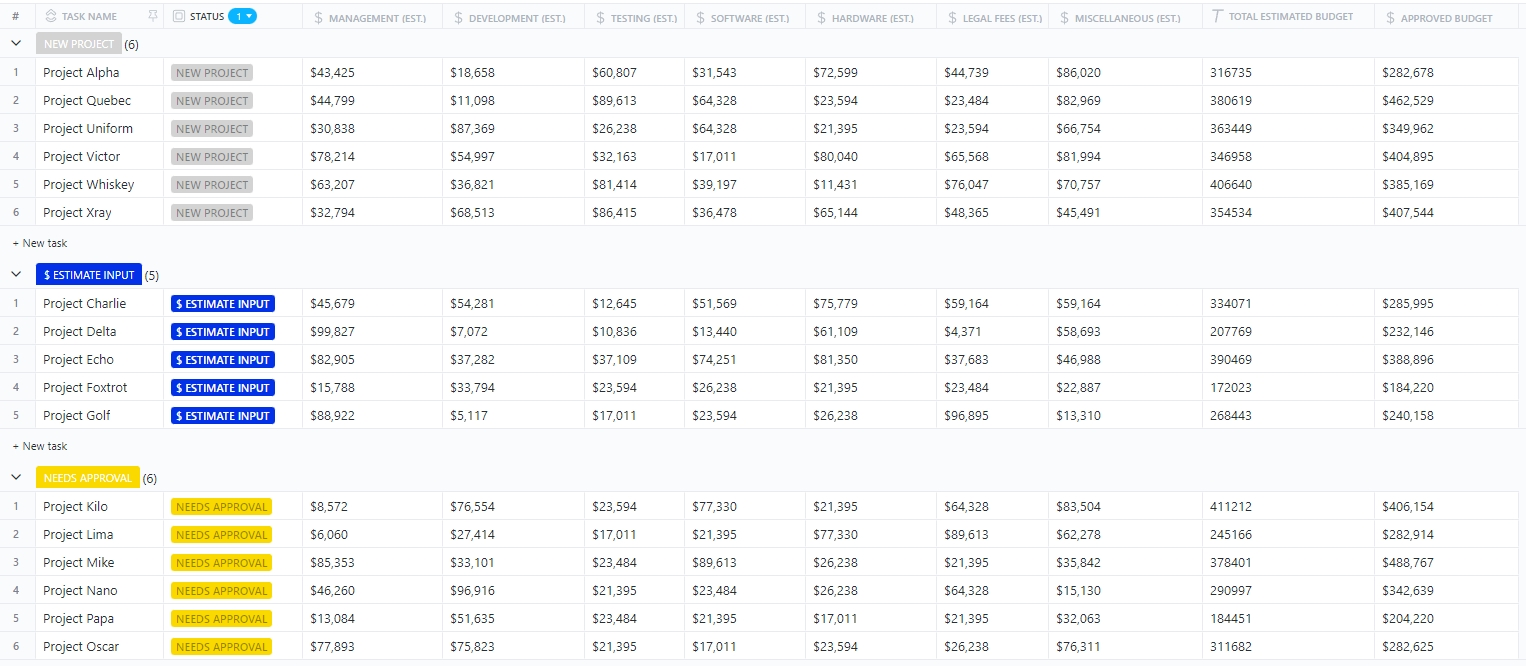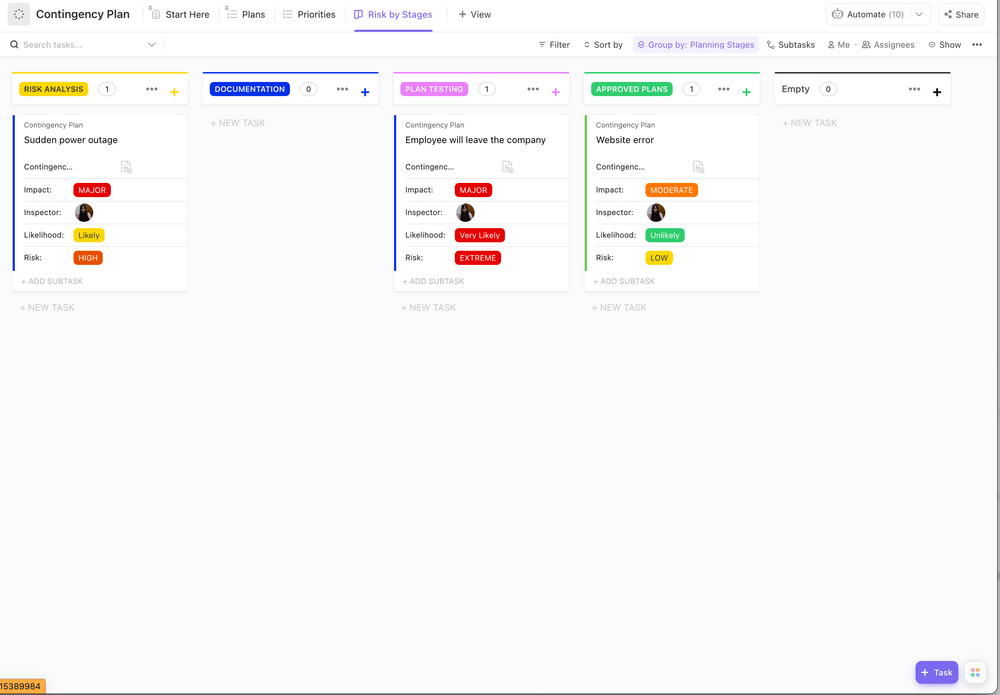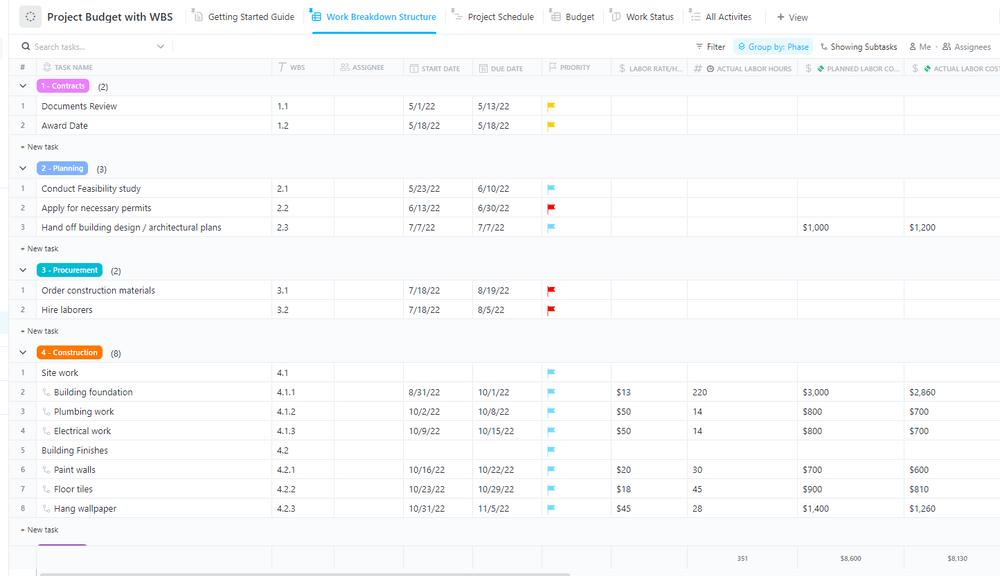"كم سيكلفني هذا المشروع؟
ربما يكون هذا أحد الأسئلة الأكثر شيوعًا والأكثر أهمية التي سيطرحها عليك أي عميل أو صاحب مصلحة داخلي. وإذا كان التقدير الذي تقدمه غير دقيق أو حتى قريب من الواقعية، فقد يعرض المشروع للخطر.
بالطبع، لا يمكن دائمًا أن يكون تقدير التكلفة دقيقًا حتى آخر دولار، ولكن تخيل أنك قدمت عرضًا بقيمة X لمشروع، لتكتشف أنك ستحتاج إلى ضعف الميزانية عندما يبدأ المشروع فعليًا.
ليس موقفاً تريد أن تجد نفسك فيه.
هذا هو المكان الذي يمكن أن يساعدك فيه هيكل توزيع التكاليف (CBS) في الحصول على صورة واضحة عن الشؤون المالية لمشروعك. فهو يقسّم جميع التكاليف المتوقعة إلى فئات يمكن التحكم فيها، مما يمنحك صورة واضحة عن أين تذهب أموالك. وهذا يمكّنك من اتخاذ قرارات مستنيرة بشأن الميزانية و إدارة تكاليف المشروع بكفاءة
بالإضافة إلى ذلك، سيساعدك أيضًا على تتبع مشروعك لمعرفة التجاوزات المحتملة للتكاليف في وقت مبكر، مما يساعدك على تسليم المشروع في الوقت المحدد وضمن الميزانية المحددة.
ولكن ما هو بالضبط هيكل تقسيم العمل (CBS)، وكيف يختلف عن هيكل تقسيم العمل (WBS)؟ سنستكشف هذه الأسئلة وغيرها في هذا الدليل.
ما هو هيكل توزيع التكاليف في إدارة المشاريع؟
تتضمن إدارة المشروع إدارة جوانب متعددة من المشروع، بما في ذلك النطاق والوقت والتكلفة. في حين أن الحفاظ على مشروعك على المسار الصحيح والوفاء بالمواعيد النهائية أمر بالغ الأهمية، فإن البقاء في حدود الميزانية لا يقل أهمية. هذا هو المكان الذي يصبح فيه هيكل توزيع التكاليف (CBS) أداة أساسية.
هيكل توزيع التكاليف هو مستند يفصّل جميع التكاليف التي سيتم تكبدها في مشروع معين. كل سطر أو صف في هيكل توزيع التكاليف يرمز إلى عنصر تكلفة مرتبط بالمشروع. وهو يقسّم هذه التكاليف إلى فئات محددة بوضوح، مما يوفر خارطة طريق مفصلة للشؤون المالية للمشروع.
لماذا يعتبر هيكل توزيع التكاليف مهمًا؟
في أي دورة حياة إدارة المشروع ، فإن الجزء الأكثر أهمية هو ضمان تسليم المشروع في الوقت المحدد وضمن الميزانية المحددة. إذا انحرف أي منهما عن مساره، فقد يكون هناك تعقيدات لنجاح المشروع بشكل عام. مع إضافة هياكل تقسيم التكاليف إلى استراتيجية إدارة المشروع الخاص بك، يمكنك:
- تحسين عملية وضع الميزانية وتقدير التكلفة من خلال تحديد جميع العناصر المحتملة لهيكل التكلفة مقدمًا. وهذا يسمح لك بتجنب المفاجآت غير السارة في المستقبل وتقليل مخاطر زيادة النفقات عن حد معين
- التخطيط لمشروعك بشكل أكثر دقة، حيث يمكنك تحديد العناصر المحتملةمخاطر تكلفة المشروع والأنشطة في وقت مبكر، مما يضمن قدرتك على تطوير استراتيجيات التخفيف من المخاطر أو تقليل تأثير هذه المخاطر
- قم بتوصيل توقعات المشروع بوضوح إلى جميع أصحاب المصلحة، بما في ذلك العملاء والجهات الراعية وأعضاء الفريق. وهذا يضمن الشفافية ويضمن توافق الجميع على هدف المشروع
الفرق بين هيكل توزيع التكاليف وهيكل توزيع العمل
يمكن أن يبدو هيكل توزيع التكاليف يشبه إلى حد كبير هيكل تقسيم العمل (WBS) حيث نقوم بإدراج جميع الأنشطة وأصحاب المصلحة المشاركين في كليهما. ومع ذلك، في حين يركز CBS على التحكم في التكاليف أو إدارة نفقات المشروع، فإن WBS يتعلق بفهم جميع الأنشطة اللازمة لإنجاز مشروع ناجح.
تتضمن بعض الاختلافات الدقيقة ما يلي:
| الجانب | هيكل تقسيم التكلفة | هيكل تقسيم العمل | |
|---|---|---|---|
| التركيز | الجوانب المالية للمشروع | نواتج المشروع ومهامه | |
| الغرض | تقسيم إجمالي تكاليف المشروع إلى فئات | تقسيم مخرجات المشروع إلى مهام يمكن إدارتها | |
| المخرجات | هيكل هرمي يحدد تكاليف المشروع | هيكل هرمي يحدد مهام المشروع ومهامه الفرعية | |
| العناصر الرئيسية | التكاليف المباشرة (العمالة والمواد والمعدات) والتكاليف غير المباشرة (النفقات العامة) والطوارئ | المهام والمهام الفرعية والمعالم الرئيسية | |
| يوفر نظرة ثاقبة | كم سيكلف كل عنصر من عناصر المشروع | ما الذي يجب القيام به لإكمال المشروع |
## تفصيل هيكل توزيع التكلفة
يتم إنشاء هيكل توزيع التكاليف باستخدام مكونات متعددة، بما في ذلك:
1. هيكل توزيع العمل
أساس هيكل توزيع العمل هو هيكل توزيع العمل الخاص بك. يحدد هذا المستند مخرجات المشروع والمهام التي تشكل مشروعك. فكر فيه كمخطط لما يجب القيام به.
2. حدد التكاليف المتضمنة في كل نشاط
بالنسبة لأي مكتب خدمات المشاريع، هناك أربع فئات رئيسية للتكاليف يجب أخذها في الاعتبار:
- تكاليف العمالة: مرتبات وأجور ومزايا أعضاء الفريق المكلفين بالمهمة. فكر في الأمر على أنه تكلفة الجهد البشري
- تكاليف المواد: المواد الخام واللوازم والمعدات اللازمة لإتمام المهمة. قد يكون هذا أي شيء بدءاً من حبر الطابعة إلى الأخشاب، اعتماداً على مشروعك
- تكاليف المعدات: استئجار أو شراء المعدات المتخصصة اللازمة للمهمة
- التكاليف غير المباشرة: وهي عوامل أخرى غير التكاليف المباشرة التي يمكن أن تضيف إلى ميزانية مشروعك. وتشمل إيجار المكتب والمرافق والتأمين والتكاليف الإدارية وغيرها
3. فهم فرصة التكلفة
لا تساعدك خطة CBS في تخطيط التكاليف فحسب، بل تساعدك أيضًا على فهم مسارات العمل المحتملة. على سبيل المثال، إذا كان عليك إنشاء موقع إلكتروني لعميل.
إذا كانت تكلفة توظيف موارد خارجية أعلى بكثير من المتوقع، فيمكنك اتخاذ قرارات استباقية مثل إكمال بعض المهام داخليًا. يساعد ذلك على تقليل التكاليف الإجمالية للمشروع ويساعدك على التحكم في جودة المشروع.
## كيفية إنشاء هيكل توزيع التكاليف
الآن بعد أن فهمت قوة هيكل توزيع التكاليف، دعنا نتعمق في الخطوات العملية التي ينطوي عليها إنشاء هيكل توزيع التكاليف. يمكنك إنشاء هياكل تفصيلية لتوزيع التكاليف باستخدام برنامج إدارة المشروع أو أداة تساعدك على تحليل أو مراقبة جميع الأنشطة والموارد المتضمنة في مشروع معين. لإنشاء هيكل تفصيلي دقيق ومفصّل لتوزيع التكاليف، يمكنك اتباع الخطوات التالية:
الخطوة 1: تعرف على جميع الأنشطة ومتطلبات الموارد
الخطوة الأولى للتخطيط الناجح للمشروع وتقدير التكاليف هي معرفة الأنشطة والموارد اللازمة لمشروعك. ويتضمن ذلك عادةً ما يلي:
- مستند نطاق المشروع: يحدد هذا المستند أهداف المشروع وإنجازاته وجداوله الزمنية. وهي بمثابة الأساس لكلٍ من WBS و CBS الخاص بك
- هيكل تقسيم العمل (WBS): يعد هيكل تقسيم العمل (WBS) المحدد جيدًا أمرًا ضروريًا لتخطيط الميزانية والمحاسبة. فهو يوفر إطار عمل لتحديد عناصر التكلفة المرتبطة بكل مهمة من مهام المشروع
- أدوات تقدير التكاليف: تتوفر أدوات مختلفة لتقدير التكاليف، بدءاً من جداول البيانات البسيطة إلى البرامج الأكثر تطوراً. اختر الطريقة التي تناسب تعقيدات مشروعك وميزانيته على أفضل وجه
الخطوة 2: تحديد فئات التكلفة
الخطوة التالية هي تقدير التكلفة المطلوبة لكل مهمة أو نشاط أو مورد. ويمكن تقسيم هذه المهام إلى جوانب متعددة حسب تأثيرها ومجال عملها، مثل
- التكاليف المباشرة: هذه هي النفقات الملموسة المرتبطة مباشرة بمهام محددة للمشروع. وهي تشمل عادةً ما يلي:
- تكاليف العمالة: الرواتب والأجور والمزايا لأعضاء الفريق المكلفين بالمهام.
- التكاليف المادية: المواد الخام واللوازم والمعدات اللازمة لإنجاز المهام.
- تكاليف المعدات: استئجار أو شراء المعدات المتخصصة اللازمة للمهام
- التكاليف غير المباشرة: غالبًا ما يشار إليها بالتكاليف العامة، وهي النفقات التي تدعم المشروع بشكل عام ولكنها لا تُعزى مباشرة إلى مهمة واحدة. وتشمل الأمثلة على ذلك:
- إيجار المكتب والمرافق
- التأمين
- التكاليف الإدارية
- اشتراكات البرامج
من خلال النظر في التكاليف المباشرة وغير المباشرة على حد سواء، فإنك تقلل من مخاطر إضافة أي مهمة أو عامل تكلفة غير معروف إلى ميزانيتك.
الخطوة 3: تقدير تكلفة العمل
بمجرد أن تأخذ في الحسبان جميع عوامل التكلفة التي ستؤثر على ميزانيتك، فقد حان الوقت للبدء في تقدير تكلفة إنجاز عنصر عمل معين. على سبيل المثال، إذا كنت ترغب في تنفيذ مهمة X، فكم من الوقت سيستغرق أعضاء فريقك لإكمالها؟ كم عدد الموارد التي سيحتاجون إليها لإكمالها؟ تتيح لك هذه الإجابات أن تأخذ في الحسبان الميزانية الإجمالية اللازمة لإكمال المهمة X.
بمجرد الانتهاء من ذلك بالنسبة لجميع المهام في مشروعك، يمكن استخدامها لتوفير التكلفة النهائية للمشروع. هذه عملية بالغة الأهمية، خاصة عند تقدير ميزانية المشاريع الكبيرة مثل مشاريع البناء.
من خلال التتبع الدقيق للمهام والموارد المطلوبة لمشروع معين والتأثيرات الأخرى باستخدام برنامج إدارة الإنشاءات ، يمكنك ضمان إنجاز مشاريعك ضمن الجدول الزمني والميزانية المحددة.
الخطوة 4: قم ببناء خطة طوارئ لبرنامج إدارة الإنشاءات الخاص بك
حتى بعد التخطيط الدقيق، يمكن أن تضيف الأحداث غير المتوقعة إلى تكاليف مشروعك. على سبيل المثال، إذا كان عليك شراء مواد من أحد الموردين ونفد مخزونها، فقد تحتاج إلى شرائها من مصدر آخر. يمكن أن تكون تكلفتها أعلى، أو قد تضطر إلى دفع مبلغ إضافي لنفس المورد إذا كانت المواد التي تحتاجها منخفضة المخزون.
وللتخفيف من هذه المخاطر، قم بتضمين هامش طوارئ في حساباتك الإجمالية. هذا هو مخفف مخصص للنفقات غير المتوقعة التي قد تنشأ أثناء المشروع. ويعتمد حجم هامش الطوارئ على عوامل المخاطرة الكامنة في مشروعك.
تعامل بفعالية مع الحوادث المستقبلية بالتخطيط السليم مع خطة طوارئ ClickUp للطوارئ
لبدء التخطيط، استخدم نموذج نموذج خطة طوارئ ClickUp للطوارئ وحافظ على سلامة وأمان عملك.
يقدم لك هذا القالب طريقة عرض القائمة واللوحة على حد سواء، مما يساعدك على رسم خطة الطوارئ الخاصة بك واستخدامها بفعالية لمشاريعك. يساعدك على إنشاء خارطة طريق واضحة للأحداث غير المتوقعة من خلال:
- تحليل المخاطر المحتملة وتأثيرها على عملياتك
- تحديد الموارد والموظفين اللازمين
- اختبار السيناريوهات البديلة لضمان أفضل النتائج في أفضل الحالات
الخطوة 5: التحقق من الإحساس
الخطوة الأخيرة في إنشاء هيكل توزيع التكاليف هي مراجعة خطتك بدقة. ابحث عن أي تناقضات أو معلومات مفقودة. شارك الهيكل التفصيلي للتكاليف مع أصحاب المصلحة الرئيسيين للحصول على مدخلاتهم ووضع اللمسات الأخيرة على المستند بعد دمج ملاحظاتهم.
تحليل هيكل توزيع التكاليف: أداة بالغة الأهمية
بالنسبة لأي مشروع، غالبًا ما يكون التأخير مكلفًا. على سبيل المثال، إذا كنا في شركة إنشاءات، فإن تأخيرًا بسيطًا في شراء الموارد قد يعني تعطل العمل، وقد يؤدي ذلك في نهاية المطاف إلى زيادة نفقات المشروع ككل. هذا هو السبب في أن استخدام تحليل CBS أمر بالغ الأهمية بالنسبة للمؤسسات.
من خلال التحليل المنتظم لهيكل توزيع التكاليف، يمكنك التأكد من مراقبة البيانات المالية والجداول الزمنية لمشروعك باستمرار، مما يساعد على الحد من مخاطر التكلفة. وهذا يساعد أيضًا في:
- الإدارة الاستباقية للتكاليف، حيث يمكنك تحديد تجاوزات التكلفة في وقت مبكر واتخاذ إجراءات تصحيحية، مثل تعديل تخصيص الموارد أو التفاوض مع الموردين للبقاء في حدود الميزانية
- تحسين التحكم في المشروع وإدارته، حيث يمكنك مراقبة جوانب WBS عند تحليل وثائق نظام تخطيط البرامج والمشاريع
- تحديد المخاطر المحتملة، بما في ذلك تخطيط التكاليف أو الموارد، مما يتيح لك تقليل تأثيرها على مشروعك بشكل عام
عند إجراء تحليل CBS، احرص على البحث عن التأثيرات القياسية على مشروعك، مثل
- فروق التكلفة: تتبع أي انحرافات بين التكاليف المدرجة في الميزانية والتكاليف الفعلية المتكبدة. حلل أسباب هذه الفروق واتخذ الإجراءات التصحيحية حسب الحاجة.
- المعالم الرئيسية للمشروع: قم بإجراء تحليل لمعايير التكلفة القياسية فيمراحل المشروع الرئيسية لتقييم الأداء المالي وتحديد مجالات تصحيح المسار. استخدام المعالم في ClickUp لتصور أهدافك في لمحة سريعة والتأكد من أنك على المسار الصحيح لتحقيقها.
- تغييرات نطاق المشروع: يمكن أن تؤثر أي تغييرات في نطاق المشروع على التكاليف. قم بتحليل حساباتك الإجمالية لفهم الآثار المالية المترتبة على تغييرات النطاق والتأكد من توافقها مع الميزانية الإجمالية.
## تنفيذ نظام تخطيط البرامج والمشاريع باستخدام ClickUp
للحصول على التقدير الأكثر دقة لمشروعك، يجب أن تكون قادرًا على تقسيم جميع المهام، بما في ذلك جميع الموارد والتكاليف الفعلية والتكاليف اللوجستية وكل نشاط متضمن. بالنسبة لمعظم الشركات، غالبًا ما يكون هذا الأمر صعبًا لأن جميع أنشطتها وفرقها تعمل في صوامع وعلى منصات مختلفة.
هذا هو المكان الذي يكون فيه برنامج إدارة المشاريع مثل ClickUp يمكن أن يساعد في جعل الأمور أكثر انسيابية وكفاءة.

طريقة عرض فريق ClickUp لإدارة المشروع وتسليمه بدقة
يتخطى ClickUp إدارة المهام الأساسية، حيث يقدم مجموعة قوية من الميزات التي تكمل احتياجاتك بشكل مثالي من CBS. فباستخدامها يمكنك
- تقسيم نواتج المشروع إلى مهام ومهام فرعية يمكن إدارتها، مما يؤدي إلى إنشاء خارطة طريق مرئية واضحة. يمكّنك ذلك من تقدير ميزانية المشروع بشكل أفضل بناءً على الأنشطة والموارد المعنية
- تتبع التكاليف المرتبطة من خلال تعيين التكاليف التقديرية لكل مهمة، وتصنيف النفقات، وتتبع التكاليف الفعلية المتكبدة. يوفر ذلك موقعًا مركزيًا لإدارة جميع الشؤون المالية للمشروع
- عرض تفاصيل التكاليف حسب الفئة، وتتبع الفروق في الميزانية، واكتساب رؤى قيمة حول البيانات المالية للمشروع
- شارك مستند CBS الخاص بك مع أعضاء الفريق، وقم بتعيين المهام مع تقديرات التكلفة، و ابقِ الجميع على اطلاع على الشؤون المالية للمشروع من خلال التحديثات في الوقت الفعلي

قم بإدارة جميع الأنشطة المتعلقة بالمشروع بسهولة على منصة واحدة باستخدام مهام ClickUp Tasks
مع ClickUp إدارة المشاريع يمكنك الحصول على ميزات متقدمة تساعدك على:
- تخطيط وترتيب أولويات جميع تفاصيل مشروعك بكل سهولة، مما يساعد فريقك بأكمله في الحصول على فهم واضح لنطاق المشروع وتخصيصه وأنشطته
- الاستفادة منالنقر فوق الدماغ، مساعد لإدارة المشاريع قائم على الذكاء الاصطناعي، لتبسيط عملك اليومي. ويمكنه إنشاء عناصر الإجراءات والمهام الفرعية تلقائيًا، وتلخيص سلاسل التعليقات، وإنشاء جداول البيانات، والعثور على التفاصيل ذات الصلة داخل ClickUp والتطبيقات المتصلة، وإنشاء تحديثات التقدم التلقائية ومشاركتها. استخدمه كمدير لمشروعك القائم على الذكاء الاصطناعي
- احصل على توافق في الآراء بشكل أسرع وابدأ المشاريع بوضوح باستخدام منصة واحدة للتعاون بشأن رؤية مشروعك وتقدير التكاليف وتسليم المشاريع بشكل أسرع وفي حدود الميزانية
كما يوفر أيضًا قوالب تقدير جاهزة للاستخدام وقابلة للتخصيص بالكامل لمساعدتك على البدء في تقديرات مشروع CBS و WBS على الفور. على سبيل المثال ClickUp ميزانية المشروع مع قالب WBS يجعل تتبع التكاليف سهلًا وبسيطًا من خلال تقسيم مشروعك إلى مهام.
التعامل مع المشاريع المعقدة ببراعة مع ميزانية مشروع ClickUp مع قالب WBS
باستخدام هذا القالب، يمكنك تبسيط أنشطة إعداد ميزانية المشروع لأنه يتيح لك
- تخطيط الأنشطة وتقديرات التكلفة
- تنظيم جميع بيانات مشروعك في مكان واحد
- تتبع إنفاقك بشكل مستمر حتى لا تتجاوز الميزانية
يتضمن هيكل تفصيلي لتوزيع العمل (WBS)، بما في ذلك:
- حالات مخصصة: لتمييز حالة المهمة على أنها ملغاة أو منجزة أو قيد التنفيذ أو معلقة أو قيد الانتظار أو قيد التنفيذ أو قيد التنفيذ
- الحقول المخصصة: لتصنيف وإضافة سمات لإدارة مهامك وتصور أنشطة مشروعك وميزانيتك بسهولة
- طرق عرض مخصصة: لتصور معلوماتك في طرق عرض متعددة لتتبع المشروع وإدارته
- إدارة المشروع: تحسين ميزانية المشروع وتتبع WBS مع إمكانات تتبع الوقت والعلامات وتحذيرات التبعية ورسائل البريد الإلكتروني والمزيد
توفر هذه القوالب هيكلاً محددًا مسبقًا لـ WBS وحقول تقدير التكاليف ووظائف تتبع الميزانية دون الحاجة إلى القيام بجميع المهام يدويًا أو البدء من الصفر.
تتبع تكاليف المشروع مثل المحترفين باستخدام قالب إدارة تكاليف المشروع القابل للتخصيص بالكامل من ClickUp
## خطة ميزانية مشروعك مع ClickUp
إليك الدليل النهائي لمساعدتك على التفوق في تخطيط المشاريع وتقدير ميزانيات المشاريع. فهو يوفر لك صورة واضحة وشاملة عن الشؤون المالية لمشروعك، مما يمكّنك من اتخاذ قرارات مستنيرة بشأن الميزانية، وتحديد مخاطر التكلفة المحتملة بشكل استباقي، وفي النهاية تسليم المشاريع في الوقت المحدد وفي حدود الميزانية.

قم بقياس وتحليل الوقت المستغرق في المهام لضمان الإنتاجية والالتزام بالميزانية باستخدام خاصية تتبع وقت المشروع من ClickUp
باستخدام ClickUp، يمكنك أن تجعل كامل إدارة المشروع عملية أكثر فعالية وتتبع الميزانيات والمهام على نفس النظام الأساسي.
سواء كان مديرو المشاريع أو قسم الشؤون المالية أو القسم التجاري لديك، يمكنهم جميعًا العمل معًا والتخطيط للمشاريع والتعاون حسب الحاجة. أو، كما يقول مايكل سكوت، إنه فوز ثلاثي.
الكل في واحد برنامج إدارة المشاريع يتيح لك إدارة مهام سير العمل والمستندات ولوحات المعلومات في الوقت الفعلي وغير ذلك، مما يساعد فريقك على التحرك بشكل أسرع والعمل بذكاء أكبر وتوفير الوقت.
هل أنت مستعد للتحكم في تكاليف مشروعك؟ اشترك في ClickUp اليوم واختبر مزايا نهج CBS المبسط والتعاوني!
الأسئلة المتداولة (FAQ)
1. ما الذي يتضمنه هيكل توزيع التكاليف؟
يتضمن هيكل توزيع التكاليف (CBS) جميع التكاليف المتكبدة في مشروع معين. ويشمل ذلك أربع فئات رئيسية للتكاليف:
- تكاليف العمالة: الأموال التي يتم إنفاقها على الأشخاص الذين سينفذون المشروع
- تكاليف المواد: أي مواد يشتريها المشروع، بما في ذلك المواد الخام وقطع الغيار والمكونات ومستلزمات التصنيع والتأمين والشحن
- تكاليف المعدات: المعدات الفعلية
- التكاليف العامة أو التكاليف غير المباشرة: النفقات غير المخصصة مباشرةً لتكلفة محددة، مثل المساحة المكتبية والمرافق والمزايا والضرائب
**2. ما هي طريقة توزيع التكاليف؟
تشير طريقة توزيع التكاليف إلى عملية إنشاء هيكل توزيع التكاليف. وينطوي ذلك على تحديد جميع أنشطة المشروع من هيكل توزيع العمل (WBS)، وتخصيص التكاليف لكل نشاط، وجمعها للحصول على إجمالي ميزانية المشروع.
3. ما هو الفرق بين هيكل توزيع التكاليف وهيكل توزيع العمل (WBS)؟
يحدد هيكل تقسيم العمل (WBS) نواتج المشروع من خلال تقسيمها إلى مهام أصغر وأكثر قابلية للإدارة. بينما يركز هيكل توزيع العمل على الجوانب المالية للمشروع، حيث يقوم بتخصيص التكاليف لكل عنصر من عناصر هيكل توزيع العمل. ويوفران معًا رؤية شاملة لنطاق المشروع وتمويلاته.




